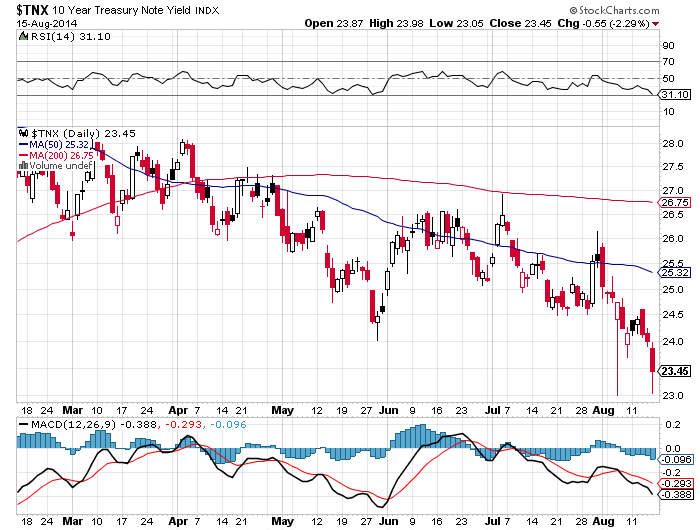The Question Of The Week: What Do Falling Yields Mean For The US Economy?
The benchmark 10-year Treasury yield closed under 2.35% last week, the lowest in more than a year. Oil prices are soft as well these days, with the spot price for West Texas Intermediate slipping into the mid-$90 range for the first time since early February. Some pundits are also pointing to last week’s flat retail sales report for July as a signal for arguing that the US economy is headed for trouble. The New York Post over the weekend “reviewed” the numbers and decided to invoke the “R” word, advancing this gem of empirical analysis to drum up fear on Main Street: “During recessions and weak growth, energy prices do fall.”
The pessimists conveniently ignore industrial production’s better-than-expected gain for last month, but a dark outlook isn’t easily distracted. It may be tempting to assume the worst in some circles, but it’s still premature to claim that the US economy is slumping. Sure, you can torture the data to say anything you want, but the old game of cherry-picking numbers in the short term is as unreliable as ever for analyzing the business cycle. In fact, a broad, diversified set of indicators tells us that the US economy was growing at a moderate pace through July, and the latest batch of figures doesn’t challenge the trend. Looking at retail spending through a meaningful prism, for instance, suggests a middling performance relative to recent history. The year-over-year change for retail sales is a moderate 3.7% gain through last month–a touch above average based on annual changes over the past year.
The initial macro profile for July is nearly complete and the data still look encouraging, including the all-important growth in payrolls of late. Will August tell us otherwise? Probably not, at least based on the early clues available so far.
The 10-year yield is sliding primarily because demand for safety around the world is on the march again–for reasons closely linked to elevated geopolitical risk beyond American shores. The US dollar is still the world’s reserve currency and so the return of a risk-off environment draws investors to the world’s proxy for “risk-free” bonds.

Sure, the US economy may ultimately stumble, but there’s no sign of that yet. There’s always a plausible scenario that could wreak havoc. Meantime, the cold, hard reality is that making high-confidence decisions about major turning points for the business cycle takes time and requires more than a handful of discouraging economic releases. Keep in mind that there’s always a weak sector to raise doubts about the overall trend. For the moment, the main slice of wobbly behavior is housing. But even here, there’s little to suggest that residential real estate is in high-risk territory as it relates to the economy overall.
All of this could change, of course, which is why monitoring the business cycle requires constant attention. Europe’s latest macro troubles represent a new risk. So, too, does the new wave of turmoil in the Middle East and the smoldering Ukraine crisis. It’s all raw material if you’re trying to write a dramatic column for the local tabloid. But history suggests in rather strong terms that you’re better off watching a broad set of economic and financial indicators before declaring that recession risk is high. This is one of the few lessons that stands the test of time in macroeconomics.
It’s also true that a robust econometric model for analyzing the business cycle is more or less worthless for columnists. Sure, there’s another recession coming. But it’s pretty clear that it didn’t start in July 2014. August probably won’t be a turning point either, unless we see a horrific reversal of fortunes in the yet-to-be published data for this month. Possible? Yes. Probable? No.
Disclosure: None.



